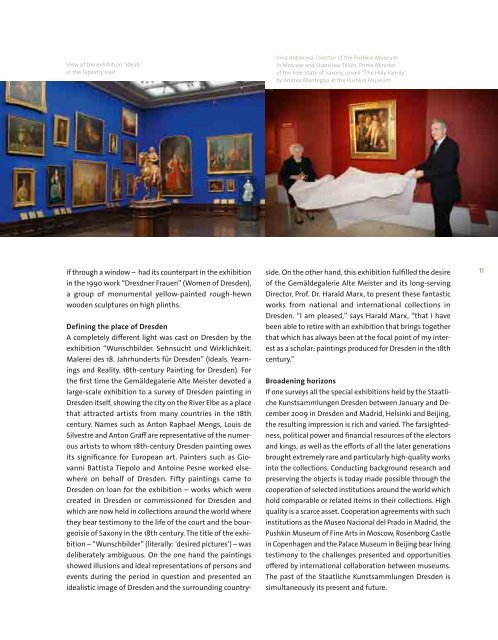2009 - Staatliche Kunstsammlungen Dresden
2009 - Staatliche Kunstsammlungen Dresden
2009 - Staatliche Kunstsammlungen Dresden
You also want an ePaper? Increase the reach of your titles
YUMPU automatically turns print PDFs into web optimized ePapers that Google loves.
View of the exhibition “Ideals”<br />
in the Tapestry Hall<br />
if through a window – had its counterpart in the exhibition<br />
in the 1990 work “Dresdner Frauen” (Women of <strong>Dresden</strong>),<br />
a group of monumental yellow-painted rough-hewn<br />
wooden sculptures on high plinths.<br />
Defining the place of <strong>Dresden</strong><br />
A completely different light was cast on <strong>Dresden</strong> by the<br />
exhibition “Wunschbilder. Sehnsucht und Wirklichkeit.<br />
Malerei des 18. Jahrhunderts für <strong>Dresden</strong>” (Ideals. Yearnings<br />
and Reality. 18th-century Painting for <strong>Dresden</strong>). For<br />
the first time the Gemäldegalerie Alte Meister devoted a<br />
large-scale exhibition to a survey of <strong>Dresden</strong> painting in<br />
<strong>Dresden</strong> itself, showing the city on the River Elbe as a place<br />
that attracted artists from many countries in the 18th<br />
century. Names such as Anton Raphael Mengs, Louis de<br />
Silvestre and Anton Graff are representative of the numerous<br />
artists to whom 18th-century <strong>Dresden</strong> painting owes<br />
its significance for European art. Painters such as Giovanni<br />
Battista Tiepolo and Antoine Pesne worked elsewhere<br />
on behalf of <strong>Dresden</strong>. Fifty paintings came to<br />
<strong>Dresden</strong> on loan for the exhibition – works which were<br />
created in <strong>Dresden</strong> or commissioned for <strong>Dresden</strong> and<br />
which are now held in collections around the world where<br />
they bear testimony to the life of the court and the bourgeoisie<br />
of Saxony in the 18th century. The title of the exhibition<br />
– “Wunschbilder” (literally: ‘desired pictures’) – was<br />
deliberately ambiguous. On the one hand the paintings<br />
showed illusions and ideal representations of persons and<br />
events during the period in question and presented an<br />
idealistic image of <strong>Dresden</strong> and the surrounding country-<br />
Irina Antonova, Director of the Pushkin Museum<br />
in Moscow and Stanislaw Tillich, Prime Minister<br />
of the Free State of Saxony, unveil “The Holy Family”<br />
by Andrea Mantegna at the Pushkin Museum.<br />
side. On the other hand, this exhibition fulfilled the desire<br />
of the Gemäldegalerie Alte Meister and its long-serving<br />
Director, Prof. Dr. Harald Marx, to present these fantastic<br />
works from national and international collections in<br />
<strong>Dresden</strong>. “I am pleased,” says Harald Marx, “that I have<br />
been able to retire with an exhibition that brings together<br />
that which has always been at the focal point of my interest<br />
as a scholar: paintings produced for <strong>Dresden</strong> in the 18th<br />
century.”<br />
Broadening horizons<br />
If one surveys all the special exhibitions held by the <strong>Staatliche</strong><br />
<strong>Kunstsammlungen</strong> <strong>Dresden</strong> between January and December<br />
<strong>2009</strong> in <strong>Dresden</strong> and Madrid, Helsinki and Beijing,<br />
the resulting impression is rich and varied. The farsightedness,<br />
political power and financial resources of the electors<br />
and kings, as well as the efforts of all the later generations<br />
brought extremely rare and particularly high-quality works<br />
into the collections. Conducting background research and<br />
preserving the objects is today made possible through the<br />
cooperation of selected institutions around the world which<br />
hold comparable or related items in their collections. High<br />
quality is a scarce asset. Cooperation agreements with such<br />
institutions as the Museo Nacional del Prado in Madrid, the<br />
Pushkin Museum of Fine Arts in Moscow, Rosenborg Castle<br />
in Copenhagen and the Palace Museum in Beijing bear living<br />
testimony to the challenges presented and opportunities<br />
offered by international collaboration between museums.<br />
The past of the <strong>Staatliche</strong> <strong>Kunstsammlungen</strong> <strong>Dresden</strong> is<br />
simultaneously its present and future.<br />
11

















